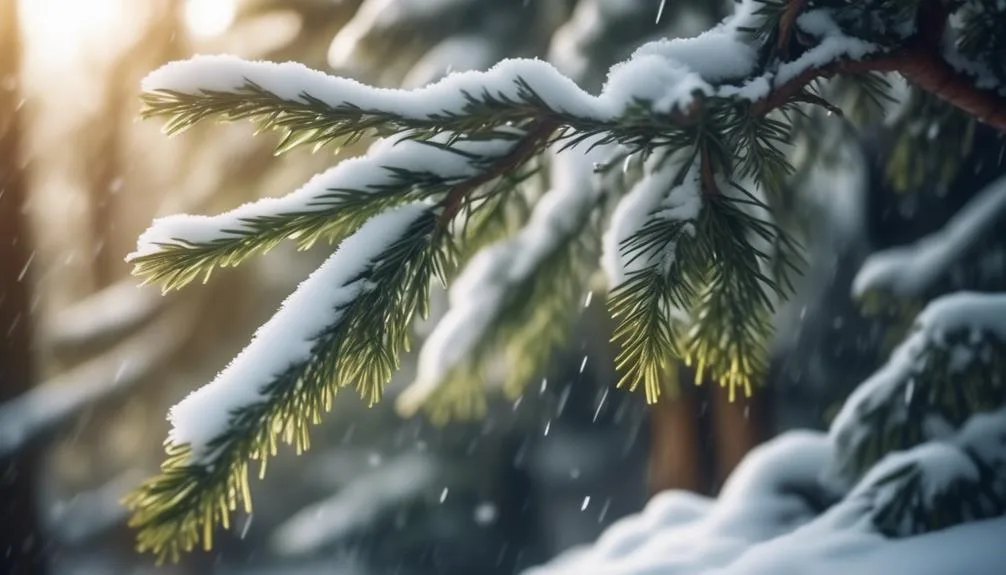Maintaining cedar trees in different climates is like caring for a diverse garden, each needing specific attention. Whether in a dry desert or a humid coastal area, the challenge is the same: keeping cedar trees healthy.
With the right knowledge, you can meet the unique needs of various climates and help your cedar trees thrive. Let's explore the essential techniques for maintaining cedar trees in different environments to ensure their longevity and beauty.
Understanding Cedar Tree Climate Needs
To best understand the climate needs of cedar trees, consider the specific environmental conditions required for their optimal growth and health.
Cedar trees are remarkably adaptable, thriving in a range of climates from the cool, moist conditions of the Pacific Northwest to the hot, dry climates of the Mediterranean. Their adaptability is evident in their ability to withstand both extreme cold and drought.
Understanding cedar tree climate needs involves recognizing their preference for well-drained soil and sufficient sunlight. They're also resilient in the face of temperature fluctuations and can tolerate both acidic and alkaline soil.
When considering climate considerations for cedar trees, it's essential to prioritize adequate air circulation to prevent disease and optimal water drainage to avoid waterlogging.
Pruning Techniques for Different Climates
How can you effectively prune cedar trees in different climates to promote optimal growth and health?
- Understanding Winter Protection: In colder climates, it's crucial to prune cedar trees in late fall to early winter. Remove any dead or damaged branches, and shape the tree to prevent heavy snow accumulation.
- Promoting Summer Growth: In warmer climates, prune cedar trees in late winter to early spring to encourage new growth. Trim back any overcrowded branches to allow for better air circulation and sunlight exposure.
- Maintaining Health Throughout: Regardless of the climate, always use sharp, clean tools when pruning to prevent disease transmission. Additionally, be mindful of the tree's natural shape and growth pattern to avoid over-pruning, which can stress the cedar tree.
Watering Cedar Trees in Various Environments
In maintaining cedar trees in various environments, the frequency and method of watering play a crucial role in their overall health and vitality.
Watering frequency is essential in ensuring the well-being of cedar trees. In hot and arid climates, it's crucial to water the trees deeply but infrequently to encourage deep root growth.
On the other hand, in more temperate and humid environments, more frequent but lighter watering may be necessary to maintain optimal soil moisture levels.
It's important to monitor the soil moisture regularly to ensure it remains consistently damp but not waterlogged.
Adjust your watering schedule based on weather conditions and the specific needs of cedar trees in your environment.
Soil and Sunlight Requirements
When considering the soil and sunlight requirements for cedar trees in different climates, it's important to understand how these factors influence the overall health and growth of these resilient trees.
- Soil pH: Cedar trees thrive best in slightly acidic to neutral soil with a pH range of 5.5 to 7.0. It's crucial to test the soil pH and amend it if necessary to create the ideal growing conditions for cedar trees.
- Sunlight Exposure: Cedar trees generally prefer full sunlight, but some species can tolerate partial shade. Understanding the specific sunlight requirements of the cedar tree species you're dealing with is crucial for their healthy growth.
- Adaptation to Climate: Different cedar tree species have varying soil and sunlight requirements based on their natural habitat and climate adaptation. Understanding these adaptations is essential for successful cultivation and maintenance.
Common Challenges in Diverse Climates
To successfully maintain cedar trees in diverse climates, it is important to be aware of the common challenges that may arise and how to address them effectively. Two crucial aspects of cedar tree maintenance are pest control and disease prevention. Cedar trees are susceptible to a variety of pests and diseases, and addressing these challenges promptly is essential to their health. Here are some common challenges and effective solutions:
| Common Challenges | Effective Solutions |
|---|---|
| Insect infestations | Regular inspection and appropriate insecticide application. |
| Fungal diseases | Proper pruning to improve air circulation and fungicidal treatments. |
Conclusion
Successfully maintaining cedar trees in different climates hinges on understanding and meeting their specific needs. This includes factors such as pruning, watering, and adjusting soil and sunlight. By prioritizing these considerations, cedar trees can thrive and enhance their surroundings, regardless of their location.
How do you plan to ensure the health and vitality of cedar trees in diverse environments?

My interest in trees started when I first saw the giant sequoias in Yosemite.
I was a teenager then, and I remember thinking, “I need to learn more about this.”
That moment stuck with me.
A few years later, I went on to study forestry at Michigan Tech.
Since graduating, I’ve worked in a mix of hands-on tree care and community education.
I’ve spent over ten years helping people understand how to plant, maintain, and protect the trees in their neighborhoods.
I don’t see trees as just part of the landscape.
They are living things that make a real difference in our daily lives.
